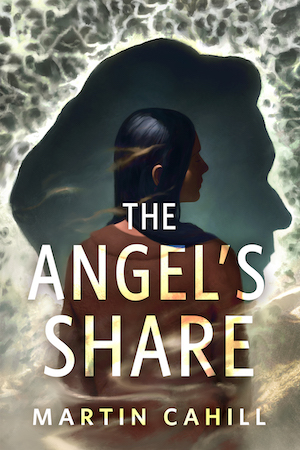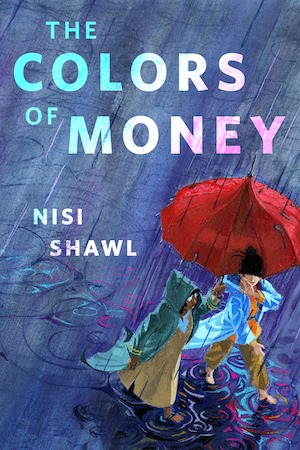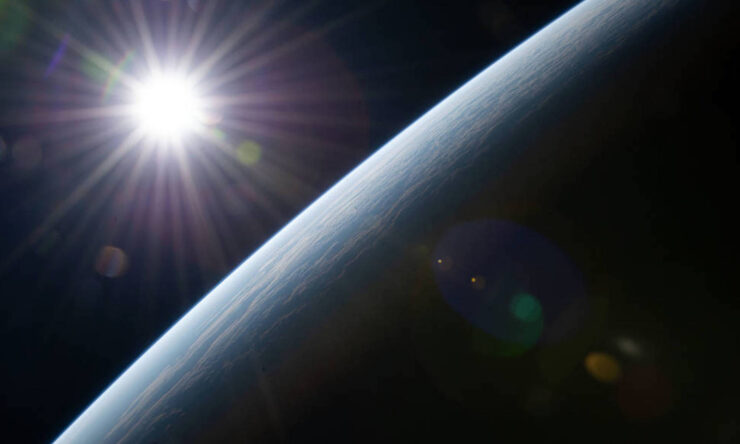The first time I felt truly rattled by our climate future—not just concerned, but properly terrified—was in reading a fantasy novel, David Mitchell’s The Bone Clocks. In 2014, the climate crisis brought on by the massive human dumping of greenhouse gases into the atmosphere could still be somewhat spectral and technical to me, part of a swirl of wonky political news alongside health care exchanges and bank capital requirements. The Bone Clocks isn’t even about climate change—it’s about reincarnating psychics having mind-laser battles with soul vampires—but the last stretch of the novel takes place post-climate apocalypse, complete with roving gangs terrorizing starved, feeble suburban ruins.
Not exactly groundbreaking: we’ve toured these ruins many times over, especially in the classic post-nuclear stories from the mid-to-late twentieth century. Those hellscapes were warnings, trying to talk us off the ledge of mutual nuclear annihilation (“You maniacs, you blew it up!” etc.), and you find an equivalent impulse in depictions of the climate apocalypse like Mitchell’s.
In Liu Cixin’s Death’s End, the third novel in his Remembrance of Earth’s Past science fiction trilogy, the final set piece contemplates the entire universe’s extinction; reading it on the heels of Trump’s election in 2016 gave me a similar sense of enlarging despair, a sobering appreciation of the stakes. “Things like the fate and goal of the universe used to be only ethereal concerns of philosophers,” one character explains, “but now every ordinary person must consider them.”
Maybe this all worked, too, for me at least. By the end of 2018, I’d shifted my career to environmental law, and I now work full-time on climate change and greenhouse gas regulation. My fiction also tacked hard toward the speculative, in part because strict realism felt inadequate to the moment. Only stories of anxious, hyperbolic futures and hallucinatory secondary worlds could get at that feeling of barreling toward the end of ours.
In my first weeks on my new job, I spent a lot of time simply absorbing climate projections: the IPCC reports, the science assessments, adaptation plans of coastal cities, airports, power grids, and naval bases. Climate projections are usually organized into scenarios: possible atmospheric CO2 by 2100 (the representative concentration pathways or RCPs), or policy scenarios in which emissions are reduced aggressively, robustly, middlingly, or not at all. Each of these scenarios is its own exercise in speculative world-building, with different levels of average temperature increase, sea level rise, and associated impacts. Each reads like a recitation of plagues: storms, fires, famine, pestilence, locusts. The degree of damage varies dramatically, though. And, once you adjust to the vertigo of contemplating a billion versus hundreds of millions of displaced climate refugees, that becomes a profound, if not particularly pleasant, kind of hope.
* * *
These speculative nonfictions also threw into relief the way climate change isn’t an apocalypse, not in a biblical or mythological sense. In certain Christian eschatologies, the Great Tribulation purges the Earth and makes way for a millennium of peace; in the Ring of the Nibelungs, the flooding of the Rhine and the burning of Valhalla usher in a renewed, human era freed from the corrupt pacts of old gods. There’s something cathartic and formally convenient in fiction, in the mode of J.G. Ballard’s The Drowned World, that deploys climate disaster as a global table-clearing, imagining survivors picking through the rubble of an ended world, positioning the disfigured monuments of our exhausted present as a new, lawless frontier for the next generations’ adventures.
But climate change isn’t one spasm of disaster, and it’s not really an “end” of the world. Climate experts are increasingly confident that, while we’re not in good shape, the worst-case pathway is probably not what we’re on. There’s still the risk that certain “tipping points,” like the runaway melting of polar ice, will accelerate warming, in which case it’s hard to predict how bad things will get and how fast. But as far as human emission go, a combination of rapid progress in low- or zero-carbon transportation and power generation, powerful carbon regulations in some key economies, and other policy interventions and strokes of luck in the past two decades have taken us off the “business as usual” pathway of RCP 8.5, the truly apocalyptic 4-5 degrees Celsius warming scenario. Also, patching the ozone hole probably saved us a whole fricking 2.5 degrees. In case you hadn’t heard.
That means the “Venus” scenario—in which Earth becomes literally uninhabitable for complex life—is not so likely anymore. Those “billions” (of dead, displaced, devastated) become “hundreds of millions”; loss of species and ecosystems moves from “all” to “most.” Progress! There’s still plenty of disaster to avert, but look: disaster is avertible.
It also means that, however hotter and harder Earth gets, the notion of a firm discontinuity between our present and future generations is more difficult to justify imaginatively. Climate change is an ongoing degradation of the globe that is happening already, sometimes in discrete, highly disruptive disasters, but more so as a creeping attrition. Nothing is overthrown, but everything is worse.
* * *
Now, I am not above writing a post-climate apocalypse secondary world. (I’m doing so right now in fact.) But I am increasingly attracted to climate fiction that abstains from or problematizes the apocalypse and reflects this newish state of play. Kim Stanley Robinson’s The Ministry for the Future, Charlie Jane Anders’ The City in the Middle of the Night, and N.K. Jemisin’s The Broken Earth fantasy trilogy—to name just a few recent favorites—all take place “mid” apocalypse, tracking a more or less functioning society interfacing with an attritional, ongoing, and profoundly dynamic environmental crisis. Robinson’s Ministry for the Future marshals policies and interventions to slow or reverse Earth’s climate catastrophe as it unfolds before our eyes. More obliquely, Anders’ complex societies poised in the temperate zone of a tidally locked planet, with lethal, permanent day on one side and frozen permanent night on the other, offer a rich study of how adapting to harsh climates shape social organization. In N.K. Jemisin’s Broken Earth books, the environmental apocalypse kicks off in the first pages, but we track its different communities’ adaptation strategies in real time as the climate worsens.
These mid-apocalyptic stories do essential work in capturing the surreal, low-key hum of dread of living through a patient and too-vast-to-apprehend crisis—a “hyperobject,” as Jeff VanderMeer describes it, “something of unknown intent and size and pervasiveness,” which every so often erupts into violent immediacy. VanderMeer’s Southern Reach trilogy tracks an unknowable phenomenon transforming a wild coastal zone, Area X, into a disturbing, hallucinatory new forms; the slow creep of Area X, and the slow-burn derangement of the organization studying it, could readily stand for the more familiar weird horror of our changing climate. In Jenny Offill’s Weather (a favorite non-speculative piece of climate fiction), our narrator answers emails for a climate futurist’s podcast, allowing her to knit multiple threads of anxiety into all-too-familiar modern litanies:
People Also Ask
What will disappear from stores first?
Why do humans need myths?
Do we live in the Anthropocene?
What is the cultural trance?
Is it wrong to eat meat?
What is surveillance capitalism?
How can we save the bees?
What is the internet of things?
When will humans go extinct?
The mid-apocalyptic climate stories also enforce on an emotional level what the science tells us: that we are intimately accountable to the world that comes after us. Apocalypses let us off the hook: What’s the point of trying if the Earth is doomed? How can this clean bus program or that wetland conservation project—not to mention one ordinary person’s decisions—matter at all, against those stakes? But climate change will not erase the slate; any future world will remember, in a ruthlessly embodied and practical way, in its scars, decisions we make and don’t make over the next few decades.
* * *
What I find most exciting about climate fiction is how it attempts to answer that problem of scale: What does individual integrity and agency mean in a collective crisis? In the American political imagination, we’ve struggled to agree on the importance of each individual’s decision to reduce their carbon footprint, or sign up for health insurance, or get vaccinated, when the public welfare depends on all or most people making a similar decision. In climate fiction, that ethical question becomes a formal one, because a story about climate change, with a protagonist whose goals, obstacles, and interiority intersect with the climate crisis, is implicitly a hypothesis about how to situate individual action within the collective stakes. Robinson and Jemisin’s characters are people whose institutional power or supernatural abilities (maybe that’s the same thing?) position them to make a meaningful impact on the global-scale crisis. In Claire Vaye Watkins’ Gold Fame Citrus, the protagonist has no real agency within the crisis, but her uncanny past as a poster child for California’s conservation programs positions her to track that crisis metonymically, a super-witness for the aridification of the Southwest.
I don’t have firm answers, but I do gravitate toward fiction that orients attentively toward non-human communities. Like the trees in Richard Powers’ The Overstory, the octopode civilization in Ray Nayler’s The Mountain in the Sea, or the weird, insidious life of Area X in VanderMeer’s Annihilation. And not just non-human life itself, but the way human characters brush up against it, how we become preoccupied with, fluent in, and responsive to ecosystems greater than ourselves.
My novella “Uranians,” which will appear in my debut collection this May, didn’t start out as climate fiction—it’s about a queer commune of artists and scientists on a long-haul interstellar voyage, a “degeneration” ship—but the story became more and more about the crew’s relationship to the ship’s closed biome providing them oxygen, food, and water, and what kind of trans-biotic relationship could sustain such high-stakes interdependency, and what that might have to say about our own stakes. “What do you mean by interconnected?” asks a caller to the futurist’s podcast in Weather. “There is a pause and then the ecologist speaks: There is a species of moth in Madagascar that drinks the tears of sleeping birds.”
Attention, here, is not just anxiety or concern about what will happen—it’s not the “Pay attention!” of scolding tweets, or mournful memorializing. It’s more like practice. Practice to bring about the shift in thinking we need to conceive of proper cross-species interdependency and respect. To rehearse in our imaginations the cooperation envisioned at the climax of Death’s End, so that we can recognize and step into the opportunities that come our way, however large or small. To think at scale, and not flinch.
Theodore McCombs is a writer in San Diego. His fiction and essays have appeared in Best American Science Fiction & Fantasy 2019, Guernica, The Magazine of Fantasy & Science Fiction, Lightspeed Magazine, Nightmare Magazine, Lit Hub, Electric Literature, and Beneath Ceaseless Skies, among others. His debut collection, URANIANS, will be published by Astra House Books in spring 2023, along with his debut novel some time after that. He’s blogged a lot about speculative literature for Fiction Unbound, he tweets as @mrbruff, and he’s on Instagram at @theodore.mccombs.










